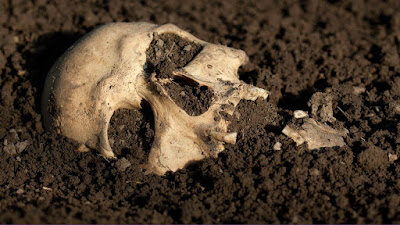A Discourse
on the Confession of Harmful Deeds
Spoken by Yama Dharmarāja to
Karma Chakme
ཨོཾ་ཇོ་བོ་ཐུགས་རྗེ་ཆེན་པོ་འཕགས་པ་སྤྱན་རས་གཟིགས་དབང་ཕྱུག་ལ་ཕྱག་འཚལ་ལོ། །
Oṃ. Homage to the great
compassionate lord, noble Avalokiteśvara!
ཨོཾ་བཛྲ་དགེ་བ་བཅུ་ཧཱུྃ།
om benza
gewa chu hung
Oṃ
vajra gewa chu1 hūṃ
ཤིག་བསད་པའི་སྡིག་པ་དག་པར་ཤོག །
shik
sepé dikpa dakpar shok
May
the harmful deed of killing lice be purified.
ཨོཾ་བཛྲ་ཡ་མནྟ་ཀ་ཧཱུྃ།
om benza
ya manta ka hung
Oṃ
vajra yamāntaka hūṃ
མི་བསད་པའི་སྡིག་པ་དག་པར་ཤོག །
mi sepé
dikpa dakpar shok
May
the harmful deed of killing human beings be purified.
ཨོཾ་བཛྲ་རོ་ལ་ཁ་ནི་ཏྲ་ཧཱུྃ།
om benza
ro lakha ni tra hung
Oṃ
vajra rola khana nitra hūṃ
རྟ་བསད་པའི་སྡིག་པ་དག་པར་ཤོག །
ta sepé
dikpa dakpar shok
May
the harmful deed of killing horses be purified.
ཨོཾ་བཛྲ་ཛ་ཧཱུྃ་ཡ་ཧཱུྃ།
om benza
dza hung ya hung
Oṃ
vajra dza hūṃ ya hūṃ
མནའ་ཟོས་པའི་སྡིག་པ་དག་པར་ཤོག །
na zöpé
dikpa dakpar shok
May
the harmful deed of breaking oaths be purified.
ཨོཾ་བཛྲ་ཤ་ཤ་འབད་ནི་ཧཱུྃ།
om benza
sha sha bé ni hung
Oṃ
vajra sha sha be ni hūṃ
རི་བོ་དང་གཙུག་ལག་ཁང་དང་ཟམ་པ་རྣམས་མེས་བསྲེགས་པའི་སྡིག་པ་དག་པར་ཤོག །
riwo
dang tsuklakhang dang zampa nam mé sekpé dikpa dakpar shok
May
the harmful deeds of burning hills, temples and bridges be purified.
ཨོཾ་བཛྲ་འབུམ་ཁྲི་ཧཱུྃ་ཧྲཱིཿཧཱུྃ་ཀ་ཧཱུྃ།
om benza
bum tri hung hrih hung ka hung
Oṃ
vajra bum tri hūṃ hrīḥ hūṃ ka hūṃ
ཐམས་ཅད་ལ་དུག་དྲངས་པ་དང་མི་དགེ་བ་བཅུ་བྱས་པའི་སྡིག་པ་དག་པར་ཤོག །
tamché
la duk drangpa dang migewa chu jepé dikpa dakpar shok
May
the harmful deeds of poisoning others and committing the ten non-virtues be
purified.
ཨོཾ་བཛྲ་ཡ་ས་པ་ཡི་ས་པ་ཡ་ནི།
om benza
ya sapa yi sapa ya ni
Oṃ
vajra ya sa pa yi sa pa ya ni
འབུ་བསད་པའི་སྡིག་པ་དག་པར་ཤོག
bu sepé
dikpa dakpar shok
May
the harmful deed of killing insects be purified.
ཨོཾ་བཛྲ་སི་ས་ར་ཡེ་སྭཱ་ཧཱ།
om benza
si sara yé soha
Oṃ
vajra si sa ra ye svāhā
སྒོ་ནོར་དང་རི་དྭགས་དང་ལྟོ་ལེ་བསད་པའི་སྡིག་པ་དག་པར་ཤོག །
go nor
dang ridak dang to lé sepé dikpa dakpar shok
ཨོཾ་བཛྲ་ས་ཏྭ་ཧཱུྃ།
om benza
sa ta hung
Oṃ
vajra satva hūṃ
འཇིག་རྟེན་ཁམས་ཀྱི་མི་རྣམས་ལ་ཤོད་ལ་གཤིན་རྗེ་ཆོས་ཀྱི་རྒྱལ་པོའི་ཞལ་ནས་གསུངས་པའི་སྡིག་བཤགས་འདི། ཉིན་རེ་ཚར་གསུམ་བརྗོད་ན་འཁོར་བ་ངན་སོང་གི་སྡུག་བསྔལ་ལས་ཐར་བར་ཐེ་ཚོམ་མེད་དོ། །
If you recite this confession of harmful deeds
spoken by Yama Dharmarāja (as a message to the people of the world) three times
a day there is no doubt that it will bring freedom from the sufferings of the
lower realms of saṃsāra.
ཡིད་བཞིན་ནོར་བུ་རིན་ཆེན་སྙིང་པོ་དང་འདྲ་བ་ཀརྨ་ཆགས་མེད་ལ་གཤིན་རྗེ་ཆོས་ཀྱི་རྒྱལ་པོའི་ཞལ་ནས་གསུངས་པའི་སྡིག་བཤགས་རྫོགས་སོ། །སརྦ་མངྒ་ལཾ།། །།
Thus concludes the wish-fulfilling jewel-like
confession of harmful deeds which Yama Dharmarāja spoke to the Karma Chakme.
| Translated by Adam Pearcey, 2016.
1






























